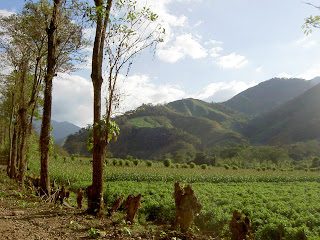The further north we went, the more lush and green the countryside became;
Finca el Cisne has been in Carlos' family since 1880. It is a working coffee and cattle ranch. It is only in the last two years that they have started to add some tourism to the mix.First on the list was horse riding in the mountains to see the coffee and cardamom plantations.
Sombrero supplied at no additional charge....
Explanation from our guide Carlos about the growing of the coffee plants; The coffee is handpicked and looks like a large red berry of sorts. It then goes to the processing part of the farm for fermentation, removal of the red skin and drying.
On the trail.....
Corn is grown everywhere.
Man made ponds forTilapia
Giving the horses a break; While we did, Carlos picked passion fruit and we tried some....really good. Carlos also picked a cardamom pod and opened it for us. We tried a seed and I recognised the taste immediately.
We returned to the ranch to an amazing lunch. By far the best I have eaten in Honduras. Starter was watercress salad with tomatoes, onion, cilantro and cheese. It was served with tortillas and another type of cheese which I can't remember the name of. It was followed by Tortilla de Malanaga con miel y jenjibre (taro with honey and ginger), pollo con chipiline (chicken with chipiline which is a locally grown flower), vegetables (of various local sorts) and yuca. It was finished with dessert of a baby banana soaked in cream, cardamom and cinamom and of course a cup of great coffee. After lunch we got to tour the coffee area. As it was Sunday there was nobody working but we got the idea of the process.
This is a very crude explanation. The red berry is fermented and the skin removed leaving a honey like coating on the bean. The beans are then washed in vats such as these. Once this coating is removed the coffee bean is dried.
This is the cheaper coffee. It floats while the better qaulity bean sinks making it easy to separate. The coffee is still very good but is mixed with skin and the beans are not as whole as the better quality ones.
Once dried the beans have a green colour. They only turn brown after roasting. Many coffee plantations do not sell thier coffee roasted. They export the green coffee bean and the company that buys their beans does the roasting. It keeps the coffee fresher for longer.
Green coffee bean ready for export;
After the tour we headed back to Copan via a quick stop at a place called agua caliente (hot springs). The water comes from far within the earth and is boiling hot in places. They have added cold water and made ponds for people to bathe and soak up the warm thermal waters. Upon getting home I noticed that I had brought some friends back with me. Four ticks that I had to pull off myself. I had had another tik take a "ride along" earlier in the week and wasn't surprised that I had picked up a few at the farm. Earlier I had to pull one off Alex.
Monday was the start of the school week. I had the morning free to go out with Ellen and Marel. We visted a place called El Barbasco, a small village way up in the mountain past San Rafael where I had visited before. Once again the road amazes me but the Hondurans just accept that this is normal and Marel luckily is a great driver. Once at El Barbasco we visited the kinder. They have nothing and I was sad to see the children with virtually nothing to play with. Ellen had brought some toys and school supplies so it was nice to help give those out.
The children have no bathroom yet lthough once is partially built. It is hard to imagine how they manage without one!
Class was uneventful but productive on Monday afternoon and the same can be said for today (Tuesday). I had four hours of class this morning and two this afternoon. Straight after class I headed to the Canopy tour on the edge of town. I will let the video do the talking. It was amazing.....
The canopy is four km's long with one section being 1km in length. I loved every minute of it! One of the best parts was that the tuk tuk driver stayed and chatted with me for a bit as I waited to get harnessed up. His sister is presently in Georgia working illegally. She travelled on the "el tren de la muerte"...the train of death, which takes immigrants north through central america to the U.S. border. If they are lucky enough to make it that far they then often cross the the river in to the USA. I knew a lot about this as I had read a book called "Enriques Journey" prior to coming here. It is a great if not sad read.
My apologies if this post is a little choppy and brief. Had a lot of homework tonight and it's getting late. Wanted to post this though before I headed home.
Out!




















No comments:
Post a Comment